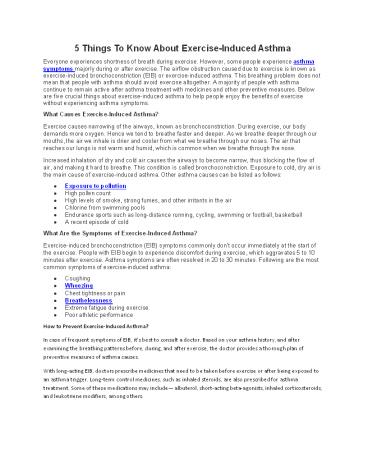Breathefree - 5 Things To Know About Exercise-Induced Asthma - PowerPoint PPT Presentation
Title:
Breathefree - 5 Things To Know About Exercise-Induced Asthma
Description:
In some patients, asthma symptoms my worsen during or after exercise. The airflow obstruction caused due to exercise is known as exercise-induced asthma. 5 crucial things about exercise-induced asthma to help people enjoy the benefits of exercise without experiencing asthma symptoms. – PowerPoint PPT presentation
Number of Views:0
Title: Breathefree - 5 Things To Know About Exercise-Induced Asthma
1
- 5 Things To Know About Exercise-Induced Asthma
- Everyone experiences shortness of breath during
exercise. However, some people experience asthma
symptoms majorly during or after exercise. The
airflow obstruction caused due to exercise is
known as exercise-induced bronchoconstriction
(EIB) or exercise-induced asthma. This breathing
problem does not mean that people with asthma
should avoid exercise altogether. A majority of
people with asthma continue to remain active
after asthma treatment with medicines and other
preventive measures. Below are five crucial
things about exercise-induced asthma to help
people enjoy the benefits of exercise without
experiencing asthma symptoms. - What Causes Exercise-Induced Asthma?
- Exercise causes narrowing of the airways, known
as bronchoconstriction. During exercise, our body
demands more oxygen. Hence we tend to breathe
faster and deeper. As we breathe deeper through
our mouths, the air we inhale is drier and
cooler from what we breathe through our noses.
The air that reaches our lungs is not warm and
humid, which is common when we breathe through
the nose. - Increased inhalation of dry and cold air causes
the airways to become narrow, thus blocking the
flow of air, and making it hard to breathe. This
condition is called bronchoconstriction. Exposure
to cold, dry air is the main cause of
exercise-induced asthma. Other asthma causes can
be listed as follows - Exposure to pollution
- High pollen count
- High levels of smoke, strong fumes, and other
irritants in the air - Chlorine from swimming pools
- Endurance sports such as long-distance running,
cycling, swimming or football, basketball - A recent episode of cold
- What Are the Symptoms of Exercise-Induced Asthma?
- Exercise-induced bronchoconstriction (EIB)
symptoms commonly don't occur immediately at the
start of the exercise. People with EIB begin to
experience discomfort during exercise, which
aggravates 5 to 10 minutes after exercise.
Asthma symptoms are often resolved in 20 to 30
minutes. Following are the most common symptoms
of exercise-induced asthma - Coughing
- Wheezing
- Chest tightness or pain
- Breathelessness
- Extreme fatigue during exercise.
- Poor athletic performance































